Disclosure: Meeple Mountain received a free copy of this product in exchange for an honest, unbiased review. This review is not intended to be an endorsement.
The Oxford English Dictionary defines the word ‘loam’ as “a fertile soil of clay and sand containing humus.” It goes on to define the word ‘humus’ as “the organic component of soil, formed by the decomposition of leaves and other plant material by soil microorganisms.”
Loam (coming to Gamefound in May of 2023) is a game about plants using chemical inputs in order to build healthy soils on which to thrive. A fitting title considering the subject matter.
In Loam, players take on the roles of the plants, playing cards from their hands in order to lure the various microorganisms from the soil into their own root systems where these organisms will form communities and, ultimately, score points for the players. Microorganisms added to a player’s root system will boost one to three stats and possibly earn the players special, one-time-use bonus cards with powerful effects.
Points come from having diverse communities and also from maintaining a balance between the three stat tracks. At the end of three rounds of play, players will tally up their final scores to determine the winner.
Of course, this is just a high-level overview of the game. If you think you’ve heard enough and just want to know what I think, feel free to skip ahead to the Thoughts section. Otherwise, read on as we learn how to play Loam.
Germination
A game of Loam is set up thusly:

First, the players create the Soil. The Creature cards are shuffled into a deck, six of which are drawn and placed face-up. Then, the Behavior card display is created by shuffling together the Behavior cards into a face-down deck and dealing out three beside it, face-up.
Then, each player receives a Soil Profile (i.e. a Player board) along with one each of the three Stat counters. Players also receive a Reminder card, a Soil Health Point Tracker card, and a copy of each of the three different types of Input cards (flipped to their basic side) which they will take into their hand along with a Creature card drawn from the top of the Creature deck.
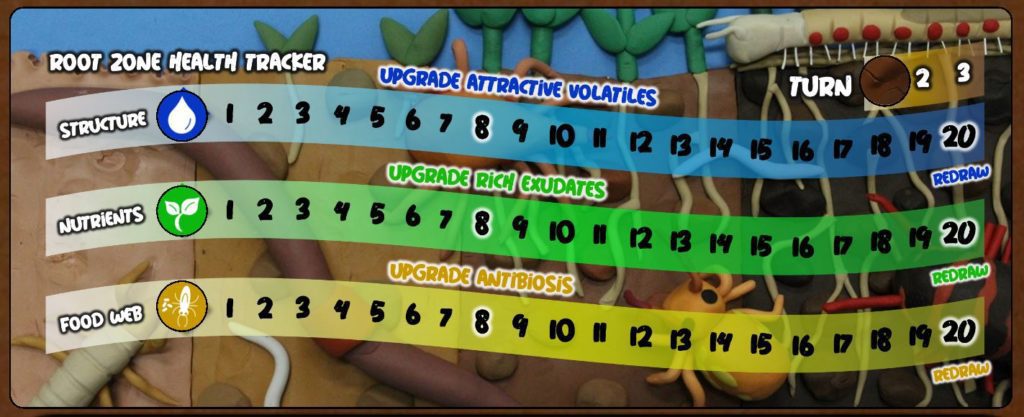
Then a start player is determined by some means and you’re ready to play. As far as game setups go, Loam is one of the fastest and easiest I’ve encountered in my lengthy stint as a game reviewer.
Taking Root
On a player’s turn, they play all three of their Input cards (as well as any number of Behavior cards they may have collected and wish to play). After playing their cards, they draw a new card from the Creature cards deck, refill the Soil to six cards if need be, and refill the Behaviors to three if any were taken. Then it’s the next person’s turn.
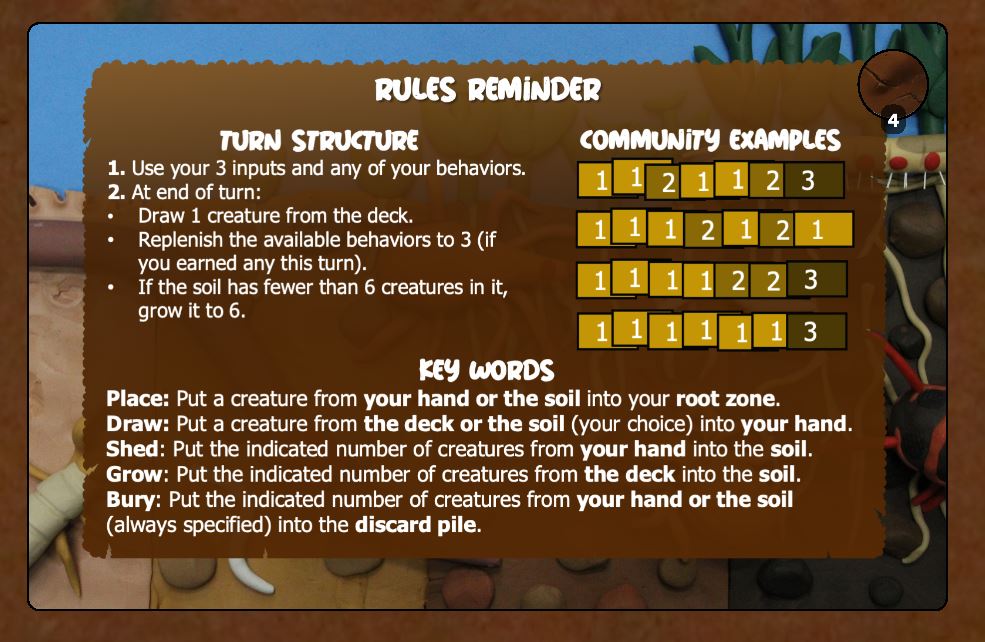
In general, Input cards are played to do one (or some combination of) the following:
Placing a card from the Soil or your hand into your Root Zone (your play area).
Drawing a creature from the Soil, or from the Creature deck, into your hand.
Shedding (discarding) a card from your hand, or the top of the Creature deck, into the Soil.
Burying creatures from the Soil (removing them from the game).
The objective of these actions is to score the most points by building the best Communities as well as maintaining a balance between the game’s three different stats: Structure, Nutrients, and Food Web.
To make sense of that, let’s examine some Creatures to gain a better understanding of how they work and how they are used to form Communities.
What Lies Beneath
The backs of the cards in Loam inform us: “There are more things living in a spoonful of soil than there are humans on Planet Earth.” That’s a pretty staggering—and sobering—factoid. And before I stray too far from intriguing facts, here’s another: Loam features 86 unique different Creature types and each of them have been lovingly crafted using clay.
You heard that right. Clay. As in, someone took the time to painstakingly sculpt each and every one of them in great detail. More specifically, we have the game’s lead designer, Max Helmberger, to thank. Before designing Loam, Max put his soil ecology PhD skills to work making stop motion animation videos for his students. Not only is the feat of sculpting so many Creatures itself highly impressive, but the visual impact this choice of artistic medium makes cannot be overstated; it’s unlike anything I’ve seen in a boardgame before, and it really works.
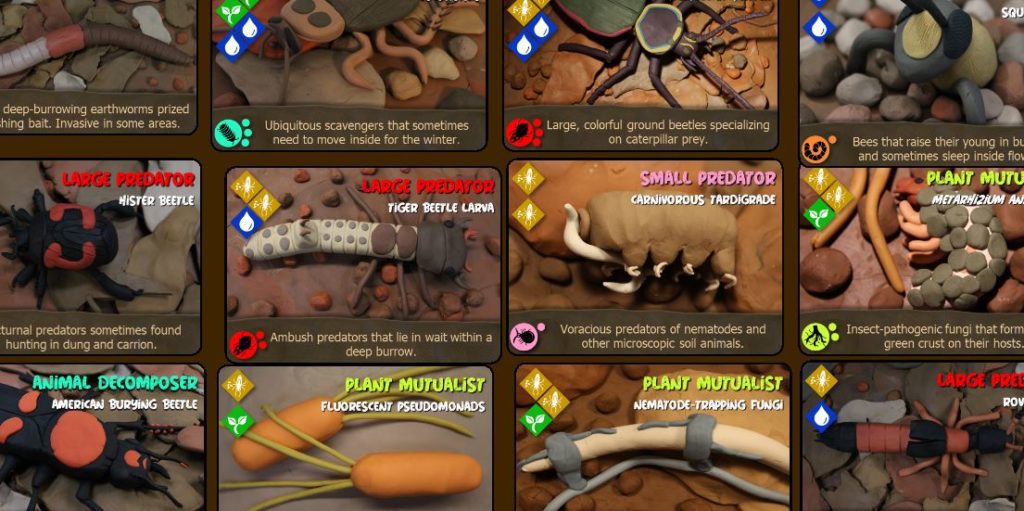
Each of these Creatures displays symbols in the upper left corner of the card that correspond to the different stat tracks. For each symbol shown, the matching stat is raised accordingly when the Creature is placed into your Root Zone. If a stat ever reaches eight, then you get to flip one of your Input cards to its opposite side, which provides a better, more souped up version of the power on its basic side for the remainder of the game.
Each Creature card also displays the Creature’s name, a fact about the Creature, the Creature’s type, and the Creature’s level, indicated by one, two, or three dots. The Creature’s level determines when, and where, it can be placed within a Community.
Every Level I Creature can be placed anywhere, including as a standalone Community by itself. Every Level II Creature in a Community must be accompanied by two Level I Creatures. And a Level III Creature cannot be placed into a Community unless that Community contains at least six other Creatures. Also, two Communities can be combined at any time and no Community may never exceed the maximum size of seven Creatures.
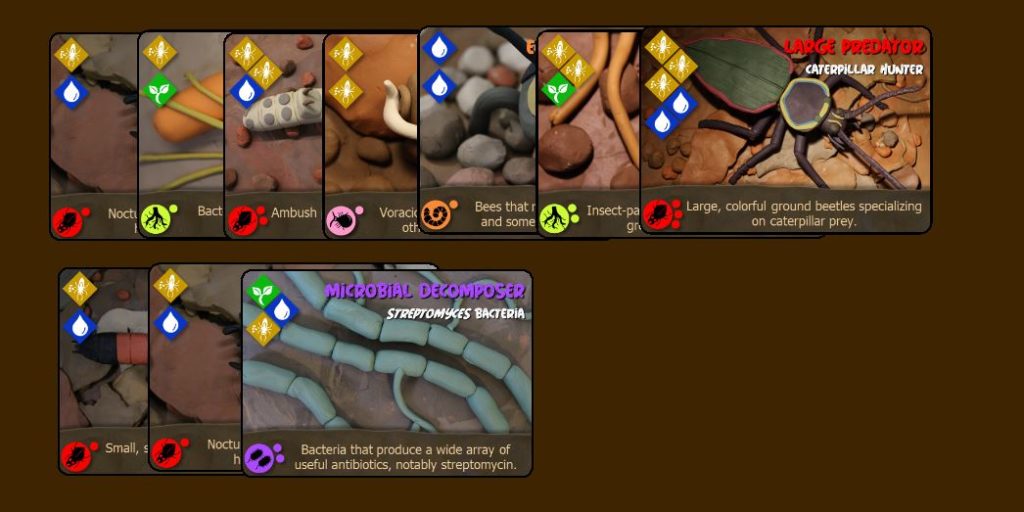
That may sound a little confusing, but it quickly becomes second nature as you’re playing the game. The real challenge isn’t remembering the placement rules, but deciding where to place your Creatures, and that all comes down to Behavior cards and the way that scoring works.
You’ll Want to Behave’in These Cards
Behavior cards are powerful, game changing cards that allow the players using them to accomplish far more with their turns than they would otherwise. Oftentimes, these come in the “Do X to achieve Y” variety—shed a card to place two Creatures, place a Creature of one type followed by another of lesser value of some other type, etc.
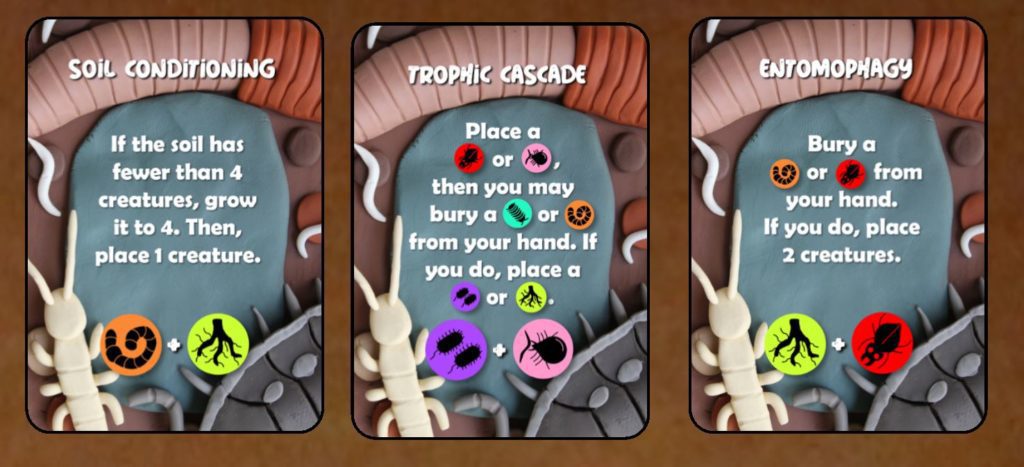
Each Behavior card shows two Creature type icons at the bottom of it. If you place a Creature with a matching symbol into a Community next to a Creature matching the other symbol, then you can claim the Behavior card from the line up. This card can be played immediately or it can be held onto until some other opportune time if you’d prefer. But keep in mind, unlike Input cards which return to your hand at the end of the turn, Behavior cards are one-shots. After using them, they are buried into their own discard pile.
Bearing Fruit
At the end of the third round, the game ends and final scoring is performed to determine the winner.
First, each separate Community is scored thusly: one point for each Creature type (and a bonus two if all six Creature types are present). Each Community also scores an extra five bonus points per Creature type of which all three Levels are present within it.
Secondly, the players score a varying number of points based on how well balanced their stats are. The highest stat is compared to the lowest to determine the difference. The lower that number, the more points are earned. So, it behooves the players to pay attention to the Creatures they’re placing so that a large disparity doesn’t occur, thereby costing them precious points at the end of the game.
Thoughts
While I sit here trying to string my thoughts together about Loam, I find myself see-sawing between two contrasting states: one of dismissal and one of acceptance.
On the one hand, Loam is not the type of game I’d ever normally play. It’s small. It’s simplistic. And it’s fast. I am a heavy euro guy. I love sitting down for a game like Tiletum, staring down the barrel of a two or three hour long ordeal, pushing meeples, vying for bonuses, and fulfilling contracts. I enjoy the way games like these make my brain burn. I derive a lot of joy and satisfaction from watching how all of the disparate mechanics mesh together to form a machine unlike anything I’ve ever experienced before. It’s exciting.
Loam is not one of these games. It’s quite the opposite, in fact. It takes maybe a minute to set up, maybe two or three to teach. And twenty minutes later, you’re putting it away. My initial draw to the game was just how much it resembled a product I would have expected to see from a publisher like Genius Games. When I volunteered to take it on, I was excited to try it out. After receiving it, though, I was wondering if I’d made a mistake. I could tell from the rulebook that Loam was not the crunchy, science-driven endeavor I’d thought it would be and my first play of the game confirmed it.
It wasn’t terrible, but it wasn’t great either. I was ready to dismiss it, but then I noticed something happening that I hadn’t expected. I couldn’t stop thinking about it. As blasé as I’d felt about it initially, I found myself wanting to play it again. To be quite frank, I was obsessed with playing it again.
That’s because, despite its small size and its lightning quick play time, Loam is bursting at the seams with challenging, and satisfying, gameplay. It’s one of those games with just the right amount of stuff going on. One mechanic less and it wouldn’t work. One mechanic more and it would ruin the experience. A relationship closely resembling the stats in a Soil Profile.
On the one hand, players must find a way to keep those stats in balance, which isn’t easy. Much of your success in this regard will come down to luck of the draw, but that luck is balanced with skillful play. One might be tempted to quickly crank out a giant Community. I mean, large Communities can be worth a lot of points at the end of the game. But is the Community worth it if your stats are way out of balance? Maybe instead of adding that triple Structure Creature to your already Structure-heavy tableau, it would be better to go with that weaker Level I that boosts both your Nutrients and Food Web by one each. And, if you set that Level I aside in its own Community, you can always connect it to another Community later on.
On the other hand, Loam is a game all about building Communities. So, maybe that’s your focus. With enough Communities under your control at the end of the game, maybe you can overcome the missing points from unbalanced stats. It isn’t likely, but it’s definitely a viable strategy.
But, what attracts me to Loam more than anything else is the way that your actions begin to chain together to create some very memorable turns. I’m a sucker for this kind of thing. So, it’s no wonder that playing an Input card to play a Creature to gain a Behavior card to Shed a few cards to the Soil to play another Creature to gain another Behavior card to play an extra Level III Creature from my hand to finish up a Community to upgrade one of my unplayed Input cards—and all of this from a single Input card, mind you—really speaks to me. Loam is rife with these kinds of heady card play sequences. Long story short, the gameplay has a tendency to make you feel pretty awesome. Even when you do poorly, you still walk away with a sense of having had a good time. And, honestly, isn’t that what board gaming is all about?
My only real complaint about Loam is that, for being a game based in real science, there’s not much science involved. Other than a brief incomplete sentence on each of the Creature cards telling you a little bit about the Creature, there’s nothing here to tell you how everything ties together. There are games like Lewis and Clark, Cryptocurrency, or Cellulose (if you’re wanting something more sciencey) that provide a lot of extra context about the content the game’s built around. While wholly unnecessary, I appreciate this kind of thing. It gives me a chance to delve into the backstory and the subject matter, giving me a much better appreciation of what the game is trying to teach me. In the copy of the rule book I received, there were several blank pages at the end. It is my fervent hope that something along the lines of what I’ve described above makes it onto those empty pages. Loam isn’t just a game. It’s an opportunity to teach the end user about the science of soil ecology and it would be a shame to see that opportunity squandered.
If you’re a ‘try before you buy’ kind of person, you’ll be glad to know that you can experience Loam for yourself in its digital format here. Do keep in mind, though, that the digital format you experience may not reflect the final end-product. But it should give you a good idea of what it feels like to play.
All in all, Loam began as a game that left me feeling disappointed, but the more I listened, the more it began to speak to me. I gave it a chance and it won me over. I think that, given a chance, it’ll probably do the same for you.


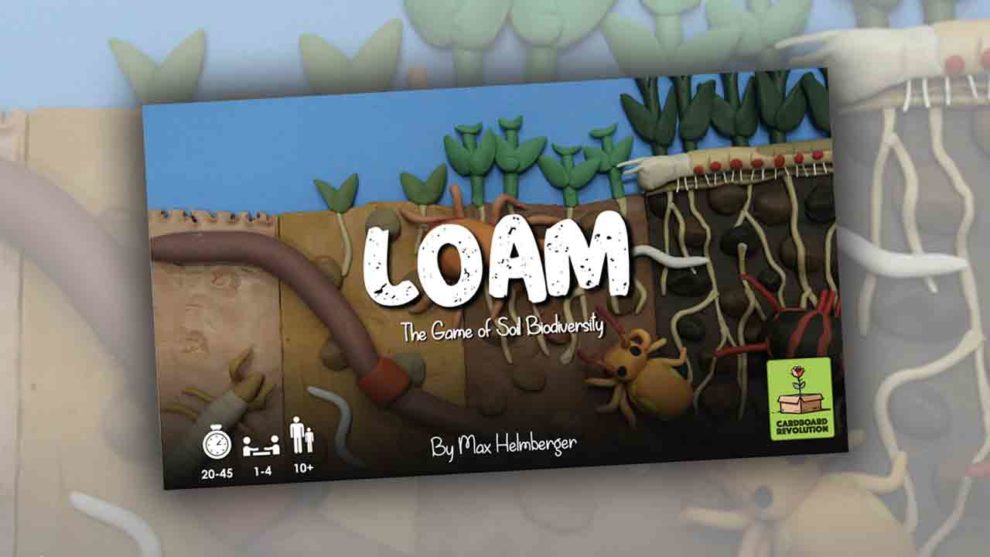








Add Comment